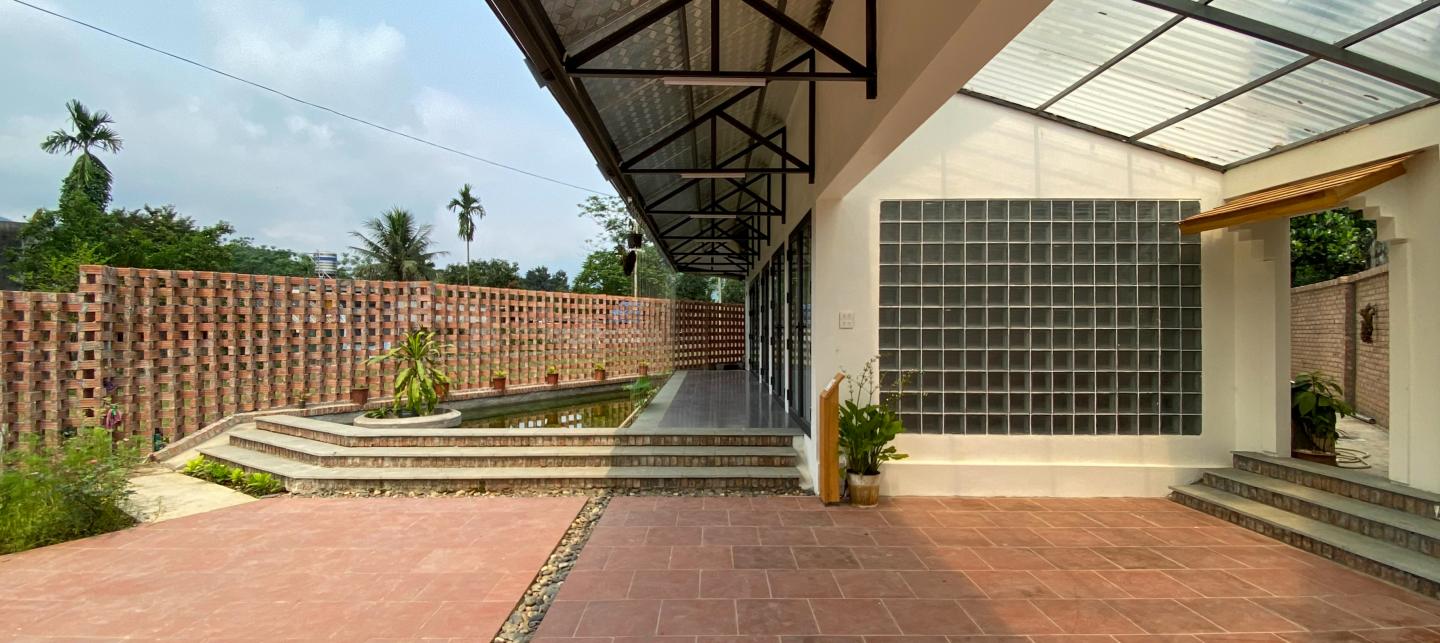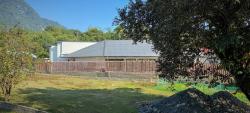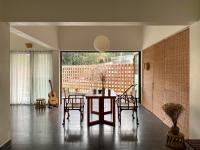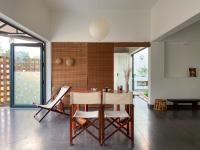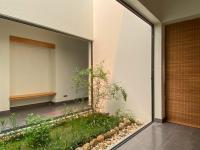As the way the house is named, "south-oriented house" is intentionally designed to take advantage of " the best geographical orientation " in a tropical context such as the sun's movement, the prevailing winds to make the house cool in summer and warm in winter. Most of the advantages that the house can offer come from the construction experience of local people in the North of Vietnam who have learned to enjoy the tropical climate for centuries.
The house is situated in Ba Thuoc district in Thanh Hoa province. This place is about 200 km from Hanoi, the capital of Vietnam. The site is surrounded by river and mountain ranges in between the towns and villages. This plot has a west-south orientation, which is a big disadvantage in summer. The owner of the house is a young family with two kids. They have basic requirements for the design that the architects have to take into consideration: 4 bedrooms, 1 kitchen, 1 living room, and 2 bathrooms with a modest budget. The design process started with studying the site. If the house’s floor plan follows the site’s orientation, it will be considerably hot in summer as more than 70% of the house envelope will orient to intense solar radiation in hot seasons. Therefore, keeping the house cool is essential in this project.
The design strategies are clearly defined by the 6 following key points:
1- There is an old saying: “ Marry a good wife and build a house facing the South”. That is a wisdom that many generations have learned to build the traditional house. It is the simplest way to gain passive cooling. For instance, it allows the house to avoid the intense heat of the sun which means the shortest sides will face east and west direction, resulting in low radiation exposure. This experience cools the house remarkably.
2- A roof that stays low to the ground and overhangs significantly to the walls is implemented to cast shadows on the house’s surface as much as possible to avoid the sun’s direct light. Like the traditional house, the new house has a deep and long veranda facing the south to create shadows at the entrance of the indoor space, this place is the most potential part to create shadow than anywhere in the house. Apart from this, this solution can reduce glare for the eyes which causes discomfort.
3- Thirdly, in tropical weather, the combination of high temperatures and high humidity causes discomfort. Ventilation that facilitates convective and evaporative cooling of the body is essential for human comfort. Therefore to cool a house in a humid-hot climate like Vietnam, the design tried to establish natural ventilation to carry the water and the heat in the air away from the house, facing south also means you maximize the cool-prevailing winds which blow frequently from that direction. For better ventilation, the nighttime activities and the daytime activities are separated by the inner courtyards to create an outlet for the air.
4- As a human’s biological clock tends to follow the sun's movement: we get sleepy when it gets dark and cool, and we want to stay awake when it gets bright. Therefore the layout should tell how human adapts to sunlight: bedrooms to the north as it requires less sunlight, and living room and kitchen to the south as they need more lights for daytime activities.
5-For better thermal insulation: the two toilets are placed on the west side and east side as a buffer zone for the bedrooms and corridors.
6-As for the landscape, we proposed a pond in front of the house and a red brick paved front yard as it is a cheap, effective cooling solution due to the ability to hold the moisture inside. The fence is also unique, instead of constructing something solid, the fence is composed of bricks with gaps in between to let the wind get inside the plot and the fence will also cool faster as there are more surfaces to expose to the air.
In general, the key design in this project is to go back to the most essential value of a good tropical house: “passive cooling” to maximize human thermal comfort. It is similar to what the traditional house can do with minimum effort: orient to the south to take advantage of nature for better natural ventilation, better thermal insulation, and create as much shadow as possible on the building’s envelope.
2021
2023
Completion Year: 2023
Gross Built Area: 175 m2
Project Location: Ba Thuoc district. Thanh Hoa province. Vietnam
Building Function: Housing
Materials: Concrete, bricks, metal, aluminum.
Team leader:Ha Duc Cuong
Design team:Ha Duc Cuong, Ha Van Bang, Nguyen Viet Loc
Favorited 1 times
